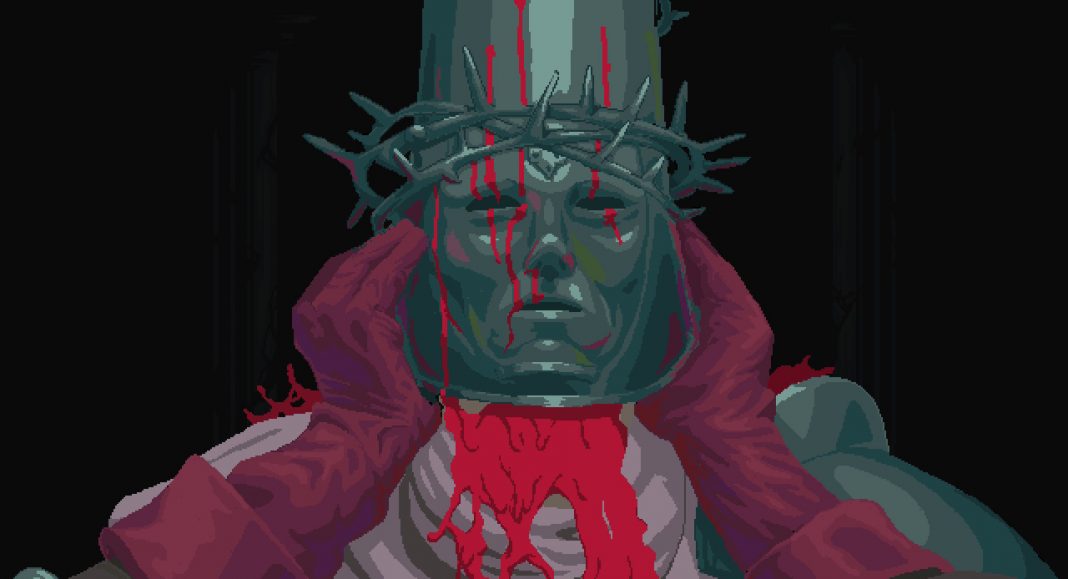Blasphemous is a good game. More than good, even. It’s a very well-crafted blend of side-scrolling metroidvania and souls-like style games with weighty combat, enjoyable puzzles, and deep lore. But it isn’t exactly revolutionary. Blasphemous lacks the fluid movement of 2018’s roguelike Dead Cells, for example. Though it does its Dark Souls imitation very well, the concepts therein feel normal by now. If it had a different style, it’d probably be another good-but-forgettable metroidvania, passed over in favor of playing Symphony of the Night for the eighth time. But the way The Game Kitchen built their world ensures that nobody who sees it will forget it anytime soon. Blasphemous may not be a horror game, but its art probably makes it the most horrific game I’ve ever played.
The World of Cvstodia
In Blasphemous, you play as the Penitent One, the sole survivor of the massacre of the Brotherhood of Silent Sorrow. The world around you is a place of desolation, with people suffering from the effects of The Miracle. The Miracle is a largely unexplained event that twists their minds or bodies with either blessings or curses. The only true power lies with the Church, a gruesome overseer that fills the citizens of Cvstodia with superstition and manic devotion.

And what a world Cvstodia is! Walking the world’s paths feels surreal, predominantly because it all seems surprisingly familiar. Most of us, whether through pop culture or personal experiences, are familiar with Christian imagery. Anyone who hasn’t seen it directly has undoubtedly seen art or architecture influenced by it. Background scenes and statues feel like we’ve almost seen them before, in a (usually) less gruesome state. And the beauty of it is, we often actually have. This Presura article by Alberto Venegas Ramos highlights some of the clearest influences on Blasphemous’ art. Seeing the pictures, you realize how littleGame Kitchen had to change in order to raise the hairs on your neck. As you wall-climb into a new zone, a palpable sense of excited dread surfaces at what might be waiting.
Here, Blasphemous’ art style does its best work. The pseudo-low-definition creates the need for your brain to interpolate images, and often your mind inserts details far more unsettling than what simply showing it could manage. You can see everything perfectly, but see nothing clearly, an eerie feeling that never quite goes away. The brutality and overt darkness of the run-through, blood-drenched, or otherwise mangled setpieces and characters hits hard, certainly. But you become adjusted to that long before the subtler elements of the game’s unsettling art.
The Penitent One
Two examples of Blasphemous’ art struck me the most. Firstly, the Penitent One himself, and I have to admit, I initially hated his design. It’s unquestionably strange, and when I saw it for the first time, it looked more distracting than anything else. But I have to admit, it stayed with me. The game came out in September for the PC, Xbox One, PlayStation 4, and Nintendo Switch, so it’d been easily available for almost two months before I ever picked it up. I’d read an article when it released with a picture of him, and nothing else. But when listening to a horror podcast, the mention of religious uses of blood brought that picture flooding back. After a day of being unable to shake it, I downloaded the game on my Switch, and couldn’t stop playing.
But what made it so memorable? For me, his helmet (seen in the images above) never quite left my head. The Game Kitchen stated Baroque and Renaissance paintings influenced them, most importantly Francisco de Goya’s A Procession of Flagellants.

The hats worn by the flagellants are capirotes, and I’ve always found them terrifying. Having grown up in the United States, it’s hard not to immediately identify them with the Ku Klux Klan, and all the violence and fear that entails. But The Game Kitchen, a Spanish studio, sees them regularly during Holy Week, worn by Catholic religious orders. They harken back to the days of the Spanish Inquisition, another historical period that heavily influenced Blasphemous art and story. That brings with it the fear a faceless entity of a powerful authority, uniquely devoted to their cause, engenders. Of course, that feeling suited the Inquisition just fine.
But in the painting above, the flagellants aren’t Inquisitors. Rather, they’re a group of people punishing themselves for their sins, hiding their faces in humiliation. Blasphemous needs both of these competing ideas to work effectively. Cruelty and shame, fear and pity. That mask and helmet convey the threatening capability of your character as well as the suffering he’s endured. And all without him saying a word. Finally, around that helmet wraps a crown of thorns. A reminder that, though the Miracle can raise you from the dead, you come bringing not peace, but a sword.
The Floating Cardinal
The second of the two pieces of design I mentioned earlier comes from an enemy. Specifically, this guy:

You first see the papal imagery, and while not inherently scary on its own, it invokes a feeling of authority. The red robes and hat are evocative of the Inquisition, but so are a lot of things in the game. What makes this character stand out is the white. There’s virtually no white in this game. Seeing the color on an enemy immediately arrests you. Combined with the chair floating above you, it feels like a perverse mockery of an angelic visit. The color is so culturally ingrained within us as representing purity that you pause. There’s a very real moment of wondering if you shouldn’t be respecting this man, rather than mercilessly unleashing your sword, Mea Culpa, upon his hovering visage. That moment…doesn’t last. But it never stops shocking you a little to see the color as you go on.
Here, again, the graphical style plays to the design’s strengths. You can barely see his face, but every time I look at it, I invariably see a deeply wrinkled man with liver-spotted hands, sneering down at me as he thrusts his weapon at an unworthy sinner. For anyone who’s seen Disney’s take on The Hunchback of Notre Dame, you might well think of Frollo. I myself rarely encounter him without a bar or two of “Hellfire” playing in my head.
The Echoes of the Past
Blasphemous’ art is shocking, evocative, and rich in history. I’m basically art illiterate, but I found Blasphemous so intriguing that I’m suddenly reading about Baroque art and religious architecture on Wikipedia. If you want a little darkness in your game, well, there’s no better place to take it from than reality. Blasphemous reminds you that, at certain point, reality looked a lot more like Cvstodia than we’re comfortable with.




